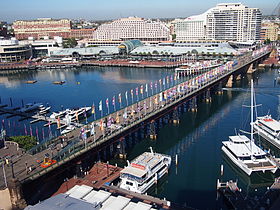Pyrmont Bridge
| Pyrmont Bridge | |
|---|---|

Pyrmont Bridge in 2014.
|
|
| Carries | Pedestrian and bicycle traffic |
| Crosses | Cockle Bay |
| Locale | Darling Harbour, Sydney, New South Wales, Australia |
| Owner | Sydney Harbour Foreshore Authority |
| Maintained by | Sydney Harbour Foreshore Authority |
| Heritage status | Heritage Council of NSW; Engineers Australia (1992) National Engineering Landmark |
| Preceded by | Pyrmont Bridge (1858–1902) |
| Followed by | Western Distributor (1981–present) |
| Characteristics | |
| Design | Swing bridge |
| Material |
Ironbark timber; Steel central spans |
| Total length | 369 metres (1,211 ft) |
| Number of spans | 14 |
| Clearance above | 6.5 metres (21 ft) |
| History | |
| Engineering design by | Percy Allan |
| Construction begin | 6 December 1899 |
| Construction cost | £112,569 |
| Opened | 28 June 1902 |
| Statistics | |
| Daily traffic | ~14,000 pedestrians |
| References | |
The Pyrmont Bridge, a swing bridge across Cockle Bay, is located in Darling Harbour, part of Port Jackson, west of the central business district in Sydney, New South Wales, Australia. Opened in 1902, the bridge initially carried motor vehicle traffic via the Pyrmont Bridge Road between the central business district and Pyrmont. Since 1981 the bridge has carried pedestrian and bicycle traffic only, as motor vehicles were diverted to adjacent freeway overpasses.
The first Pyrmont Bridge was opened on 17 March 1858, and was a wooden pile bridge with an iron centre 'swing panel' to allow ships to pass. In the first two weeks 20,000 pedestrians paid the one penny toll. It was also crossed by "932 carts and drays, 43 gigs, 17 carriages and 125 horse and rider." When the government bought the bridge for £52,500 from the Pyrmont Bridge Company in 1884, they abolished the toll. The wooden Pyrmont Bridge vanished with the construction in 1902 of a new steel bridge which took 33 months to build and was completed in time to accommodate Sydney's first cars.
The foundation stone for the new bridge was laid on 6 December 1899 by E. W. O'Sullivan and the bridge was opened for traffic on 28 June 1902 by the Governor of New South Wales, Harry Rawson. The bridge was designed under the engineering supervision of Percy Allan. The bridge had one of the largest swing spans in the world at the time of its construction and it was one of the first to be powered by electricity. Allen also designed the similar Glebe Island Swing Bridge, completed in 1903.
The Pyrmont Bridge is 369 metres (1,211 ft) long and cost £112,500 to build. The bridge is made up of 14 spans with Australian ironbark timber used on 12 spans, while the two central spans, which swing, are constructed from steel. The swingspan weighs 1,000 tonnes (1,100 short tons) and is supported on a base made from concrete and Hawkesbury Sandstone. The base is filled with mass concrete and weighs 6,800 tonnes (7,500 short tons). The swingspan is 13 metres (43 ft) in diameter and 19 metres (62 ft) deep. The water is 6.5 metres (21 ft) deep and the base extends a further 10 metres (33 ft) below the sea floor.
...
Wikipedia
